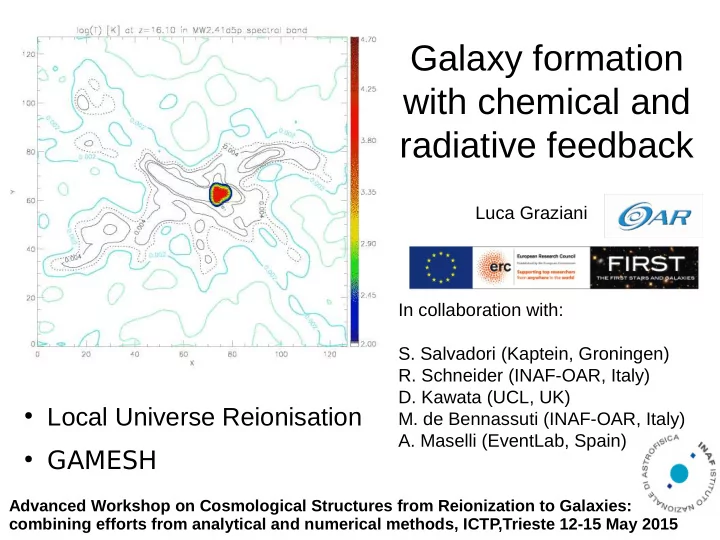

Galaxy formation with chemical and radiative feedback Luca Graziani In collaboration with: S. Salvadori (Kaptein, Groningen) R. Schneider (INAF-OAR, Italy) D. Kawata (UCL, UK) ● Local Universe Reionisation M. de Bennassuti (INAF-OAR, Italy) A. Maselli (EventLab, Spain) ● GAMESH Advanced Workshop on Cosmological Structures from Reionization to Galaxies: combining efforts from analytical and numerical methods, ICTP,Trieste 12-15 May 2015
The FIRST team and collaborators Matteo de Bennassuti, PhD Stefania Marassi, Pdoc Rosa Valiante, Pdoc Raffaella Schneider, PI INAF/OAR INAF/OAR INAF/OAR INAF/OAR Andrea Ferrara Marco Limongi Simone Bianchi Stefania Salvadori Roberto Maiolino Kazu Omukai Gen Chiaki Scuola Normale INAF/OAR INAF/OAA Cambridge Kepteyn, Groningen Tokyo University Tohoku University
GAMESH = GAMETE + CRASH + Nbody simulation of Milky Way galaxy formation N-body simulation: dynamical evolution of DM halos GAMETE simulation: Star formation, metal production CRASH simulation: RT, gas ionisation heating I 0 : GAMETE galaxies → CRASH sources I 1 : gas T, ionisation → Star forming halos GAMESH can follow both mergers ● and spatial evolution of structures GAMESH implements self-consistent ● Radiative and chemical feedback
GAMESH radiative feedback model GAMESH compares T vir of each halo with T gas of the environment ● from which cold gas can feed star formation. T gas < T vir → star formation allowed in the halo. T gas must be defined depending on the spatial extension of the ● halo environment. If R vir > 0.1 dx/2 → cells surrounding the halo cell can feed gas ● → T gas is the volume average over cells. (EXTERNAL FEEDBACK) If R vir <= 0.1 dx/2 → only the halo cell can feed gas ● → T gas is the temperature of the halo cell. (LOCAL FEEDBACK)
GAMESH Results: Pop III SFR, Pop II SFR Pop II SFR: insensitive to reionisation model. Pop III SFR: very sensitive to reionisation model. Both IReion and GAMESH provide values at z=0 in agreeemnt with observed SFR at z=0. Pop III → Pop II: sensitive to the Radiative feedback model and the interplay with chemical feedback. Pop III bubbles remain isolated in space → L ocal feedack at high-z
GAMESH Results: Radiative Feedback stats Radiative Feedback stats: sensitive to reionisation model. Radiative Feedback stats: not reflected in SFR both at high and low z. Radiative Feedback stats affected by inhomogeneities Radiative Feedback is working quite well even in low spatial resolution grids.
GAMESH Results: interplay with chemical feedback IGM metallicity sensitive to reionisation model. Evidence of Interplay between radiative and chemical feedback. High-z enrichment needs corrections. Improve mass resolution N-body Improve enrichment model
GAMESH Results: interplay with chemical feedback - MW MDF IGM metallicity sensitive to reionisation model. Evidence of Interplay between radiative and chemical feedback. High-z enrichment needs corrections. Decent MDF?! Improve low metallicity tail MDF
GAMESH Conclusions GAMESH is ready and working: first example of semi-analytic and numerical RT Coupling. Self-consistent! GAMESH is providing interesting results on low-resolution N-body simulations. Graziani et al., 2015, MNRAS, 449, 3, 3137-3148. Self-consistent radiative and chemical evolution requires better metal enrichment modelling. Better mass resolution simulations could be used to address the Missing Satellite problem!! H 2 -cooling halos require also better SF prescription and LW RT implementation. A better GAMETE is in development → Better metal enrichment scheme A better CRASH is in development → LW RT!! A new GAMESH will be ready soon!
Recommend
More recommend